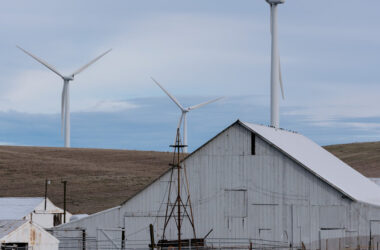Agriculture Secretary Tom Vilsack has a line about the state of small-scale agriculture in America these days.
It’s drawn from the National Agricultural Statistics Service, which shows that as the average size of farms has risen, the nation had lost 544,000 of them since 1981.
“That’s every farm today that exists in North Dakota and South Dakota, added to those in Wisconsin and Minnesota, added to those in Nebraska and Colorado, added to those in Oklahoma and Missouri,” Mr. Vilsack told a conference in Washington this spring. “Are we as a country OK with it?”
Even though the United States continues to produce more food on fewer acres, Mr. Vilsack worries that the loss of small farmers has weakened rural economies, and he wants to stop the bleeding. Unlike his last turn in the same job, under former President Barack Obama, this time his department is able to spend billions of dollars in subsidies and incentives passed under three major laws since 2021 — including the biggest investment in conservation programs in U.S. history.
The plan in a nutshell: Multiply and improve revenue streams to bolster farm balance sheets. Rather than just selling crops and livestock, farms of the future could also sell carbon credits, waste products and renewable energy.
“Instead of the farm getting one check, they potentially could get four checks,” Mr. Vilsack said in an interview. He is also helping schools, hospitals and other institutions to buy food grown locally, and investors to build meatpacking plants and other processing facilities to free farmers from powerful middlemen.
But it’s far from clear whether new policies and a cash infusion will be enough to counteract the forces that have pushed farmers off the land for decades — especially since much of the money is aimed at reducing carbon emissions, and so will also go toward large farming operations because they are the biggest polluters.
The number of farms has been declining since the 1930s, in large part because of migration from rural areas to cities and greater mechanization of agriculture, which allowed operators to cultivate larger tracts with fewer people. Over time, the federal government abandoned a policy of managing production to support prices, prompting growers to become more export-oriented while local distribution networks atrophied.
The last half-decade has been more disruptive than most. First came a trade war against China under former President Donald J. Trump, which drew retaliatory tariffs that cut into U.S. exports of farm products like soybeans and pork. Then came the pandemic, which scrambled supply chains and sapped farm labor, leaving crops to rot in the fields.
After Congress cushioned the blow with relief for farmers hurt by pandemic disruptions, things started to turn around. Even as the cost of supplies like fertilizer and seed rose, so did food prices, and farm incomes increased. In 2023, default rates on farm loans neared record lows.
“Farm balance sheets are the healthiest they’ve ever been in the aggregate,” said Brad Nordholm, the chief executive of Farmer Mac, a large secondary market for agricultural credit. “The tools available to American farmers to have a more predictable return, even when commodity prices change and input prices change, is greater than it’s ever been before.”
But wholesale crop prices are expected to decline over the coming year. Rising interest rates have made it more difficult to finance planting and harvesting, borrow for an expansion or just get into agriculture — especially since land values jumped 29 percent from 2020 to 2023.
That’s especially true for the smallest farmers, who are far less likely to be tapped into Department of Agriculture assistance programs and are more vulnerable to adverse weather, labor shortages and consumer whims.
“I think in some ways they’re in a worse position than before the pandemic,” said Benneth Phelps, executive director of the nonprofit Carrot Project, which advises small farmers in New England. “We see a lot of farmers making hard decisions right now about whether to stay in or get out, because they’ve run out of steam.”
That’s where the American Rescue Plan, the Inflation Reduction Act and the Bipartisan Infrastructure Law come in.
The laws have collectively provided about $60 billion to the Agriculture Department, which has parceled it out across a variety of priorities, from relieving farmers’ debt to paying them to reduce their carbon emissions.
The biggest chunk — about $19.5 billion — has breathed new life into subsidies to encourage conservation practices that improve the land, like cutting back on plowing and planting cover crops to sequester carbon in the soil. Some of the programs had shrunk in successive Farm Bills, which are five-year legislative packages that covers most agricultural subsidies, and about two-thirds of farmers who applied each year got nothing.
The new funding has added 16,000 recipients over the past two years. Preliminary data shows the expansion is allowing smaller farms to take part.
Some of that money — in combination with another Agriculture Department pot for renewable energy — will be used to buy a $2.9 million methane digester at Savage View Farm, a dairy in Grand Isle, Vt., with 700 milking cows.
Fed with copious amounts of manure, the machinery will generate electricity that is sold back to the local utility and dehydrated solids that can be used for cow bedding. A tax credit in the Inflation Reduction Act will decrease the farm’s tax liability, and in nonfinancial benefits, the facility will reduce the odors generated by spreading raw manure on fields.
“We have an overabundance of manure,” said Sara Griswold, a farm manager who is engaged to one of the farm’s owners. “It’ll make the experience of spreading a little more pleasant for those around us.”
Another $3.1 billion will pay farmers who are willing to do a bit more monitoring, verification and reporting to build out the science of what actually works to reduce carbon emissions.
The hope is that producers can charge a premium for goods advertised as climate-friendly. Consumers say they’re willing to pay more, and in Europe, many food companies are under regulatory pressure to source ingredients with a smaller carbon footprint. For extra revenue, the Agriculture Department envisions the development of markets where polluting companies buy carbon offsets from farms that have reduced their own emissions.
Not everyone is on board with these initiatives, however. For one thing, it can be difficult for smaller farmers to take advantage of them. The methane digester at Savage View Farm isn’t cost-effective for dairy herds with fewer than about 200 cows, for example.
Also, scientists worry that the climate benefits are overstated, and that further subsidizing farms — especially those with methane-producing livestock — might actually increase the greenhouse gases coming from the sector overall.
“Farming in general, especially if it’s meat and dairy, has higher emissions than it sequesters,” said Matthew Hayek, an assistant professor at the New York University department of environmental studies. “The more money you put into agriculture, the more agriculture that’s going to happen.”
To assist small farmers more directly, the Agriculture Department has provided additional money to help would-be farmers get started and local producers find buyers for crops other than dominant commodities like corn and soybeans.
The effort includes $300 million to help historically marginalized and aspiring farmers — including Black, Hispanic, recent immigrant and Native American growers — gain access to land. The program was vastly oversubscribed, and the money has now been parceled out to nonprofits across the country that are building community land trusts, helping heirs gain clear title to family land, and furnishing technical assistance to those just getting started.
Another bottleneck strangling smaller farmers has been the availability of meat and poultry processors, an industry that has been consolidated under huge companies like Cargill and Tyson Foods. To fix it, the Agriculture Department has reinvigorated enforcement of long-neglected antitrust laws and invested $1 billion in building or expanding plants.
After land is secured, what determines whether the farm withers or thrives is customers. A smaller operation often can’t make it on commodity prices alone, so it needs individual buyers willing to pay a bit more for a wider range of crops.
The Agriculture Department has tried to address that problem with $900 million to encourage institutions to buy from local producers, and by establishing a network of regional food business centers.
Many farmers say the money has been helpful, but it still hasn’t filtered all the way across America’s mountains and plains. Graham Christensen’s family has farmed about 1,000 acres in eastern Nebraska since arriving as homesteaders in the late 1800s. The family now has it mostly in white corn and soybeans, and has been diversifying into hazelnuts, cherries and pecans. Those are typically high-value crops, but only if someone is buying — like a grocery chain, or packaged-food company.
“We don’t have anywhere to go with those products when we’re done,” Mr. Christensen said. “Those are the markets we want, and we don’t have a way to get there.”
That’s why Mr. Christensen, and groups like the National Family Farm Coalition and American Farmland Trust, are pushing for the new funding to be continued in the coming Farm Bill. They want billions more to help transfer land from retiring farmers to small operators rather than corporations, and for the Agriculture Department to set up an Office of Small Farms to oversee it all.
Some of the money, they point out, could come from the subsidies that have propped up giant producers of wheat, corn and other agricultural products for many years.
“It’s about pushing for investments away from just one type of farm, to be more inclusive,” said Carolina Mueller, the coalition associate director of the National Young Farmers Coalition. “This is a big potential source of financial support that could be serving young, beginning and frankly not-so-young-anymore farmers.”



